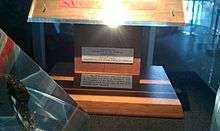New York lunar sample displays
The New York lunar sample displays are two commemorative plaques consisting of small fragments of moon specimen brought back with the Apollo 11 and Apollo 17 lunar missions and given in the 1970s to the people of the state of New York by United States President Richard Nixon as goodwill gifts.[1][2]
Description
Apollo 11

The New York Apollo 11 lunar sample display commemorative podium style plaque consists of four "moon rock" rice-size particle specimens that were collected by Apollo 11 astronauts Neil Armstrong and Buzz Aldrin in 1969 and a small New York state flag that had been taken to the moon and back on Apollo 11.[1]
The 4 "moon rocks" weigh about 0.05 grams total. They are encased in a clear plastic button the size of a coin which is mounted to a wooden board approximately one foot square on a small podium pedestal display. The display also has mounted on it a small New York state flag that had been taken to the moon and back, which lies directly below the "goodwill moon rocks". The small podium plaque display was given to the people of the state of New York by President Richard Nixon. Similar lunar sample displays were also distributed to all the other states of the United States and all the countries (at the time) of the world.[1]
Apollo 17

The New York Apollo 17 lunar sample display commemorative style plaque, measuring 10 by 14 inches, consists of one "moon rock" particle specimen that was cut from lunar basalt 70017 and a New York state flag.[2] The basalt 70017 was collected by Apollo 17 astronauts Harrison Schmitt and Eugene Cernan at the end of their third and final moonwalk.[3] Once the lunar basalt 70017 was brought back to earth from the moon, the basalt moon rock was cut up into small fragments of approximately 1 gram. The specimen was encased in a plastic ball and mounted on the wooden plaque along with the New York state flag which had been taken to the moon and back by the crew of Apollo 17. The plaque was then distributed in 1973 by President Richard Nixon to the state of New York as he did that year to the other 49 states (the same as for the Apollo 11 plaque gifts). This was done as a goodwill gesture to promote peace and harmony.[2]
History
The New York Apollo 17 "goodwill moon rocks" plaque display is now located at the New York State Museum in secure storage.[4] The 1 gram "moon rock" particle specimen in its Lucite ball has been taken off, or came off, its place on the commemorative wooden plaque display. It is unknown why the Lucite ball is separated from the top of the lunar wooden display. The Lucite ball with the "moon rock" particle specimen is not in a public viewing area at this time.[5] The museum keeps the New York Apollo 17 "goodwill moon rock" under lock and key in a high security vault and not on public display due to its high dollar value that some say could be worth as much as $10 million.[3] According to the New York State Museum, the Apollo 17 lunar sample display was taken off public showing because of security concerns triggered by the theft of the Malta Apollo 17 goodwill lunar display in 2004.[3][6]
The whereabouts of the New York Apollo 11 "goodwill moon rocks" plaque display is unknown.[1] The online publication collectSpace, the main source for the whereabouts of all Apollo 11 and Apollo 17 displays since 2005, has no record of the location of the New York Apollo 11 lunar sample display as of 2012.[1] The New York State Museum also has no knowledge of its whereabouts.[7]
References
- 1 2 3 4 5 Pearlman, Robert (1999–2012). "Where today are the Apollo 11 goodwill lunar sample displays?". collectspace.com. Retrieved November 2, 2012.
- 1 2 3 Pearlman, Robert (1999–2012). "Where today are the Apollo 17 goodwill lunar sample displays?". collectspace.com. Retrieved November 2, 2012.
- 1 2 3 Benjamin, Liz (September 23, 2011). "NY's Moon Rock Non-Mystery Solved". YNN. Time Warner Cable. Retrieved November 3, 2012.
- ↑ Ahern, Sean (December 3, 2009). "The dark side of the moon rock". spotlightnews.com. Archived from the original on February 3, 2013. Retrieved November 3, 2012.
- ↑ Dear Mr. Coldwell, I attached the release form digitally signed. I don't know how the lucite ball got separated from the plaque. The lucite ball with the 'moon rock' is not on a display area. I took the photographs after I placed the ball on a table. Marian - Curator of Geology, New York State Museum
- ↑ Associated Press (May 21, 2004). "$5M moon rock stolen from Malta museum". Valletta, Malta: Gannett. Retrieved November 2, 2012.
- ↑ E-mail 24 September 2012 from Curator of Geology, New York State Museum: Dear Mr. Coldwell, We do have the Apollo 17 goodwill moon rock in the New York State Museum Collection. Your entry for the New York rock in Wikipedia is correct; the rock is now stored in the Office of Cultural Education's secure vault. Below, you will find the information we have on this rock from our database. If you like, we can provide you with the photograph of the plastic ball containing the goodwill moon rock and the plaque. Regards, Marian. The Apollo 11 lunar display was not talked about by the museum Curator in several e-mail inquires to her about it.
Further reading
- Kloc, Joe (February 19, 2012). The Case of the Missing Moon Rocks. The Atavist/Amazon Digital Services, Inc. p. 47. ASIN B007BGZNZ8.
External links
| Wikimedia Commons has media related to Wooden plaques. |
